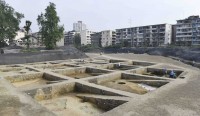 Archaeologists have rediscovered the remains an ancient temple in Chengdu, in southwestern China’s Sichuan Province, that has been lost for 1,000 years. The Fugan Temple was built in the Eastern Jin Dynasty (317-420 A.D.) and was in use through the Southern Song Dynasty (1127-1279 A.D.) when it became a casualty of the period’s wars and political instability. After years of neglect and decline, the temple fell to ruin and whatever was left of it was buried under subsequent construction. Eventually even its location was forgotten.
Archaeologists have rediscovered the remains an ancient temple in Chengdu, in southwestern China’s Sichuan Province, that has been lost for 1,000 years. The Fugan Temple was built in the Eastern Jin Dynasty (317-420 A.D.) and was in use through the Southern Song Dynasty (1127-1279 A.D.) when it became a casualty of the period’s wars and political instability. After years of neglect and decline, the temple fell to ruin and whatever was left of it was buried under subsequent construction. Eventually even its location was forgotten.
Buddhist temple construction flourished in the Eastern Jin, with almost 2,000 of them known to have been built during the dynasty. The Fugan Temple reached its zenith of importance during the Tang Dynasty (618–907 A.D.) when it was extensively renovated and expanded. Tang-dynasty poet Liu Yuxi (772–842 A.D.) wrote a poem about the renovated temple which described its “heavenly appearance” and its great importance as a religious and cultural center. Tang Dynasty monk Daoxuan (596-667 A.D.), who recorded the biographies of prominent monks, traditions and information about temples and other sacred sites, wrote about how the temple got its name. When Chengdu was suffering from a years-long drought, an official prayer rite was held in front of the temple to pray for rain and lo and behold, the heavens opened and Chengdu was delivered. The temple was named Fugan, meaning “to feel the blessing” in honor of this miracle.
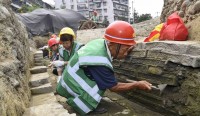 From then on, Fugan Temple was associated with rain and drought relief and became a center for people praying for water. Its decline in importance was gradual, beginning at the end of the Tang Dynasty when constant wars took a toll on the number of pilgrims visiting the temple. Fugan never really recovered from the attendant loss of prosperity, and within a couple of hundred years, it had disappeared off the map. Literally.
From then on, Fugan Temple was associated with rain and drought relief and became a center for people praying for water. Its decline in importance was gradual, beginning at the end of the Tang Dynasty when constant wars took a toll on the number of pilgrims visiting the temple. Fugan never really recovered from the attendant loss of prosperity, and within a couple of hundred years, it had disappeared off the map. Literally.
Archaeologists have now put it back on the map: specifically, Fugan Temple is under Shiye Street in Chengdu. Thus far they have unearthed the main temple’s foundations, the remains of other buildings in the complex, wells, roads and ditches in an area of 11,000 square meters. This was just a small section of the Fugan Temple at its largest after the Tang renovation and expansion, but it’s more than enough to give archaeologists a unique view into the temple’s architecture.
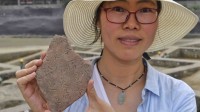 The team has also discovered a large number of artifacts attesting to the temple’s rich cultural offerings. The most stunning of them are more than 1,000 fragments of stone tablets inscribed in an elegant script with verses from Buddhist scripture including the Diamond Sutra, the Lotus Sutra and the Sutra of the Whole-Body Relic Treasure Chest Seal Dharani. Even after more than a thousand years of destruction and ruin, there are still traces of gold powder on some of the inscriptions, a hint of the awe and reverence in which these tablets were held.
The team has also discovered a large number of artifacts attesting to the temple’s rich cultural offerings. The most stunning of them are more than 1,000 fragments of stone tablets inscribed in an elegant script with verses from Buddhist scripture including the Diamond Sutra, the Lotus Sutra and the Sutra of the Whole-Body Relic Treasure Chest Seal Dharani. Even after more than a thousand years of destruction and ruin, there are still traces of gold powder on some of the inscriptions, a hint of the awe and reverence in which these tablets were held.
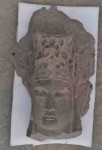 In addition to the tablets, archaeologists found more than 500 pieces of stone statues, the largest of which are more than 15 feet high. They are representations of various Bodhisattvas and of the Buddha in a wide variety of forms, each of them drawn from scripture, each of them different — zaftig Buddha, slender Buddha, solemn Buddha, peaceful Buddha, Buddha holding a lotus blossom. Archaeologists believe they were carved by different monks as a form of devotion and therefore no two of them are alike.
In addition to the tablets, archaeologists found more than 500 pieces of stone statues, the largest of which are more than 15 feet high. They are representations of various Bodhisattvas and of the Buddha in a wide variety of forms, each of them drawn from scripture, each of them different — zaftig Buddha, slender Buddha, solemn Buddha, peaceful Buddha, Buddha holding a lotus blossom. Archaeologists believe they were carved by different monks as a form of devotion and therefore no two of them are alike.
The dig has also revealed a wealth of remains and artifacts long pre- and post-dating the temple itself.
During the excavation, archaeologists found some 80 ancient tombs scattered near the temple, dating back to the Shang and Zhou dynasties (1600-256 B.C.). In the temple’s surroundings, they have unearthed large amounts of household tools, utensils and building materials dating back to various periods from the Song to the Ming dynasties.
Chengdu became an economic and cultural center in western China during the Sui and Tang dynasties. The temple’s discovery could greatly contribute to the study of the spread of Buddhism in China during that time, said Wang Yi, director of the Chengdu Cultural Relic Research Institute.
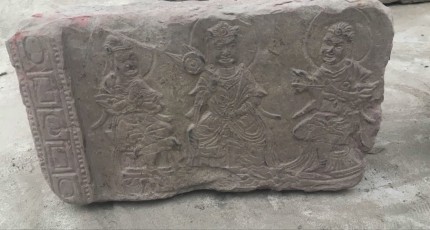
Welcome back, Chengdu! I dig those pattern-sided bricks!
What is the stone on the necklace of that attractive young woman?
Impossible to know for sure, but it looks to me like jade.
:yes: Wonderful find and great did. What marvelous work everyone involved.
Magnificent find and awesome did. What heavenly work everybody included.